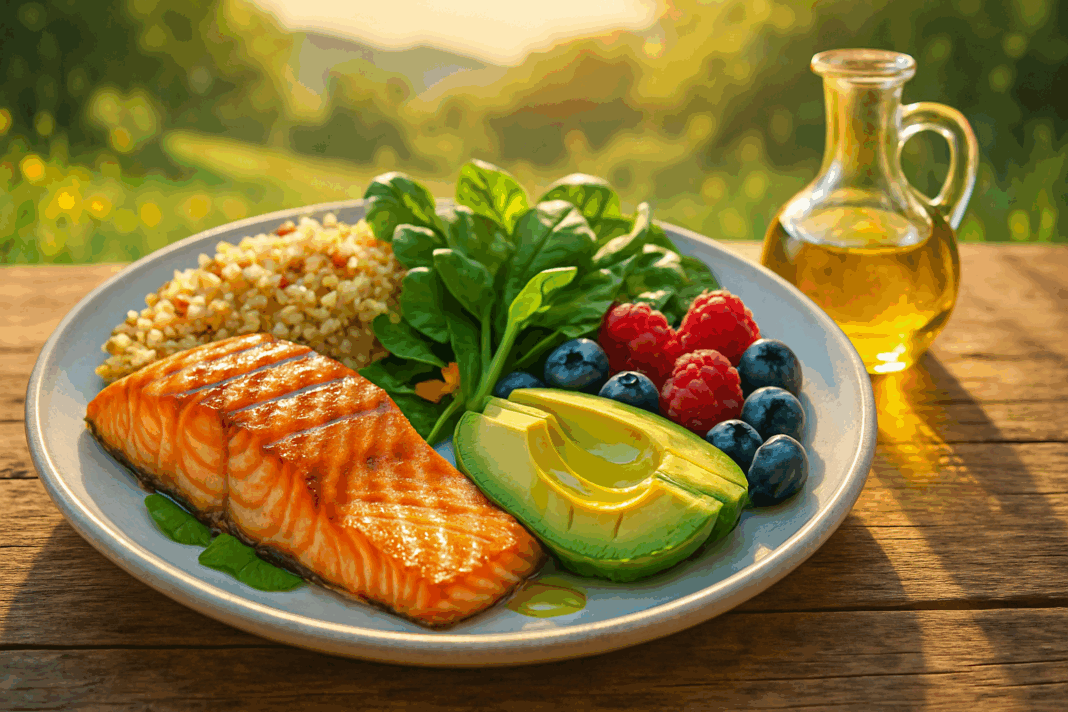Achieving and maintaining a healthy weight isn’t just about reducing calories—it’s about nourishing the body with the right foods, at the right times, in the right amounts. For those seeking a sustainable, medically sound approach, understanding what to eat for weight loss becomes a cornerstone of effective, long-term success. Rather than relying on restrictive fads or unscientific cleanses, the best strategy is to turn to evidence-based guidance from nutrition experts who emphasize the power of real food. In this article, we’ll explore the healthiest meals for losing weight, practical weight loss meal ideas, and what research-backed weight loss foods are truly worth adding to your diet.
You may also like: Expert-Backed Weight Loss Tips for a Healthier Lifestyle: What You Need to Know for Long-Term Weight Control and Wellness
For anyone wondering what is a good diet to lose weight, this in-depth guide will offer both clarity and direction. Whether you’re looking for easy healthy meals for weight loss, a targeted diet plan for weight loss for female individuals, or the healthiest diet to lose weight overall, this article is designed to deliver practical, expert-endorsed answers. Let’s begin with a closer look at the nutritional science behind weight loss and why the foods you choose matter just as much as how much you eat.
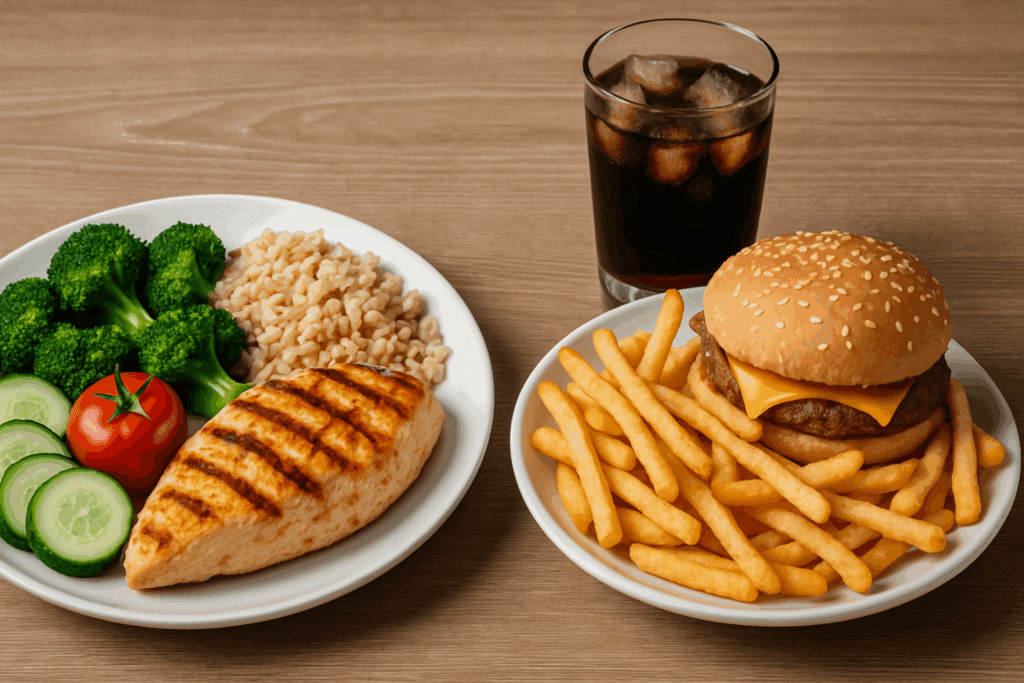
Why Food Quality Is Just as Important as Quantity
Many people fixate on counting calories, but this approach often overlooks the critical role of food quality. While calorie control is necessary for weight loss, it’s the nutritional density of meals that influences hunger, satiety, metabolism, and long-term adherence. A 500-calorie meal of lean protein, vegetables good for weight loss, and healthy fats has a vastly different effect on the body than the same number of calories from processed snacks or sugary beverages. In fact, research shows that nutrient-dense, minimally processed foods lead to better hormonal regulation, more stable blood sugar levels, and improved appetite control.
This is particularly relevant when developing weight loss meal plans that aim to promote fullness while minimizing the urge to overeat. High-fiber vegetables, quality proteins, and healthy fats work together to create satisfying meals that keep energy levels stable and hunger in check. This means individuals are more likely to sustain a calorie deficit without feeling deprived, increasing their chances of long-term success.
Moreover, easy weight loss meals that emphasize whole foods reduce inflammation and support metabolic health—two key pillars in the science of effective weight management. Simply put, the answer to what foods help you lose weight fast is often less about exotic ingredients and more about returning to basics: unprocessed, nutrient-rich meals tailored to individual energy needs.
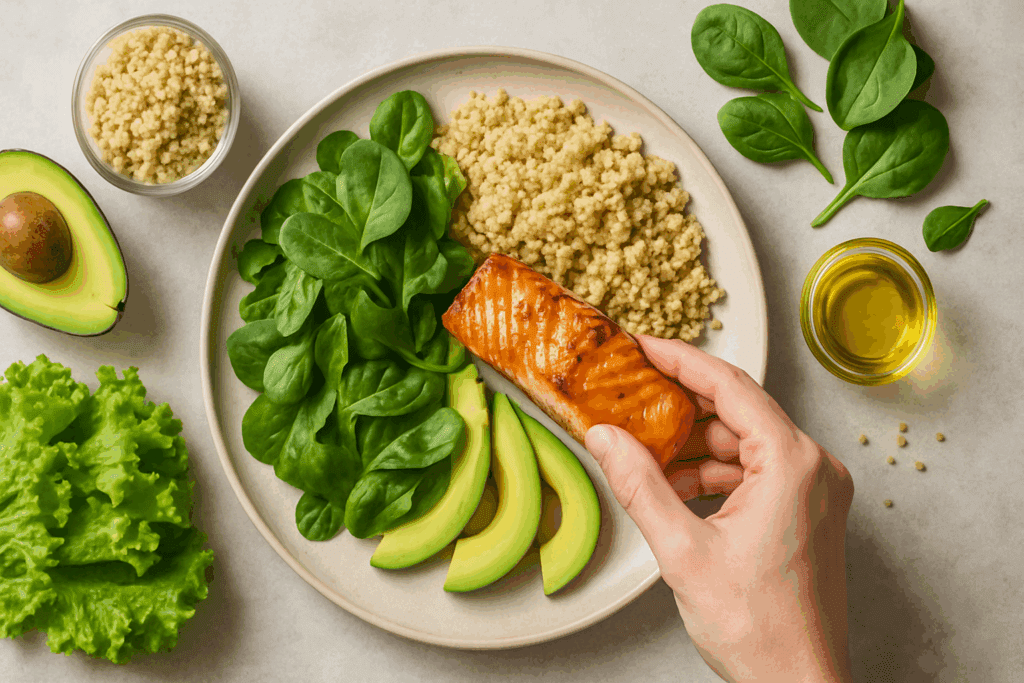
Healthy Meals for Weight Loss: Building Your Plate with Intention
One of the most practical ways to implement expert advice is by learning how to build balanced, healthy meals for weight loss. A well-composed plate should ideally feature a source of lean protein (such as fish, chicken breast, tofu, or legumes), an abundance of fiber-rich vegetables, a moderate serving of whole grains or starchy vegetables, and a small amount of heart-healthy fat.
This method supports those seeking the best diet to lose weight because it creates meals that are both nutritionally complete and satisfying. For example, a lunch consisting of grilled salmon over a bed of leafy greens with quinoa and a drizzle of olive oil hits all the right targets: protein, fiber, complex carbs, and healthy fats. Not only is this meal rich in nutrients, but it also helps control blood sugar and maintain fullness for hours.
Easy healthy meals for weight loss don’t need to be complicated. Stir-fries with tofu and mixed vegetables, grain bowls with black beans and roasted sweet potatoes, or omelets packed with spinach and mushrooms all provide the kind of slow-burning fuel that promotes fat loss without sacrificing taste or satisfaction.
Creating a bank of go-to weight loss meal ideas ensures consistency and reduces decision fatigue, both of which are essential for maintaining momentum over time. When healthy eating becomes habitual, weight management feels less like a chore and more like a natural rhythm.
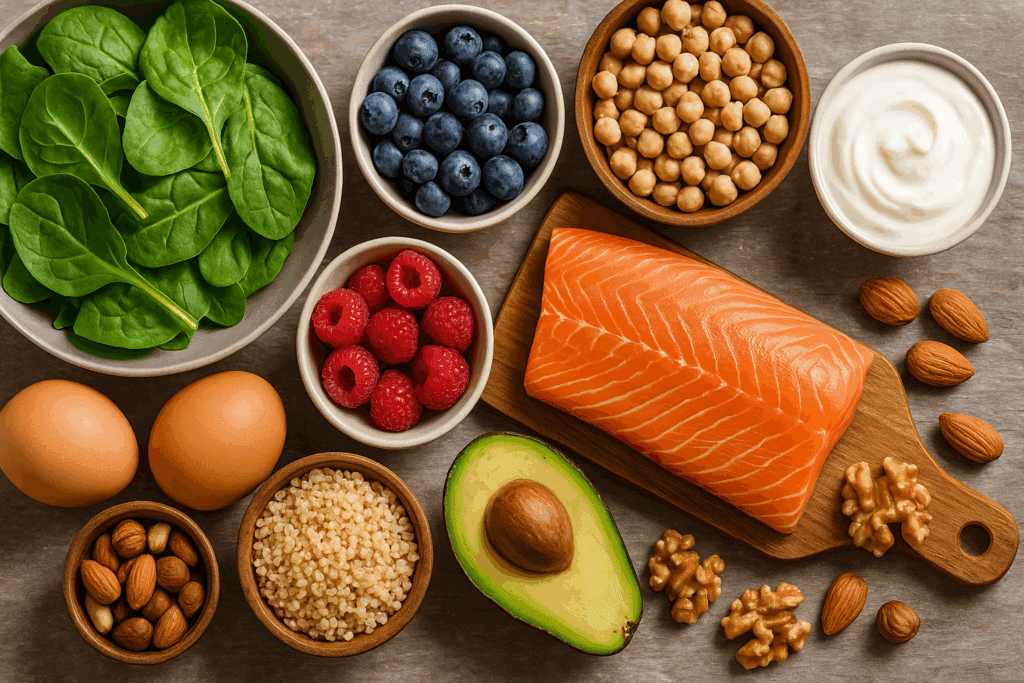
What Are the Top Foods to Eat to Lose Weight?
A growing body of research has identified a variety of weight loss foods that have unique properties making them ideal for fat loss. High-protein foods like eggs, lentils, and Greek yogurt are particularly beneficial, as they support muscle retention, increase satiety, and slightly boost metabolic rate through the thermic effect of food. Fiber-rich vegetables—especially leafy greens, broccoli, cauliflower, zucchini, and bell peppers—are vegetables good for weight loss because they’re low in calories but high in volume and nutrients.
Whole grains such as oats, brown rice, and quinoa can also be included in a healthy weight loss diet. Contrary to outdated myths about carbs, these unrefined carbohydrates are rich in fiber and support healthy digestion while contributing to long-lasting energy. When incorporated into weight loss meals, they enhance fullness and provide essential micronutrients like magnesium and B vitamins.
In addition to whole grains and vegetables, healthy fats like avocado, nuts, and seeds play an important role. These fats not only help regulate hormones related to appetite and metabolism but also add flavor and texture to meals, increasing satisfaction. Knowing what are the best foods to eat when losing weight requires looking beyond just calories and focusing on how foods affect the whole body—physiologically, psychologically, and metabolically.
Easy Weight Loss Meals: Simplifying the Process Without Sacrificing Nutrition
One of the most common barriers to healthy eating is time. Fortunately, there are countless easy weight loss meals that are quick to prepare and full of flavor. A breakfast of overnight oats with berries and chia seeds, a lunch of rotisserie chicken wrapped in lettuce with hummus and sliced cucumber, or a dinner of baked cod with roasted Brussels sprouts and wild rice all qualify as quick, nutritious options.
Many people searching for what to eat when trying to lose weight are also trying to simplify their routines. By focusing on easy, repeatable combinations that are high in protein and fiber, it becomes easier to meet nutritional needs without overthinking every meal. Easy weight loss meals don’t mean bland or boring—they just mean meals that can be prepped in minutes, stored well, and enjoyed repeatedly.
Meal prepping on weekends or batch-cooking healthy staples like grilled chicken, roasted vegetables, and quinoa can also cut down on weekday stress. These prepped components can be mixed and matched into different combinations, creating a diverse array of weight loss meal ideas without needing a new recipe every day.
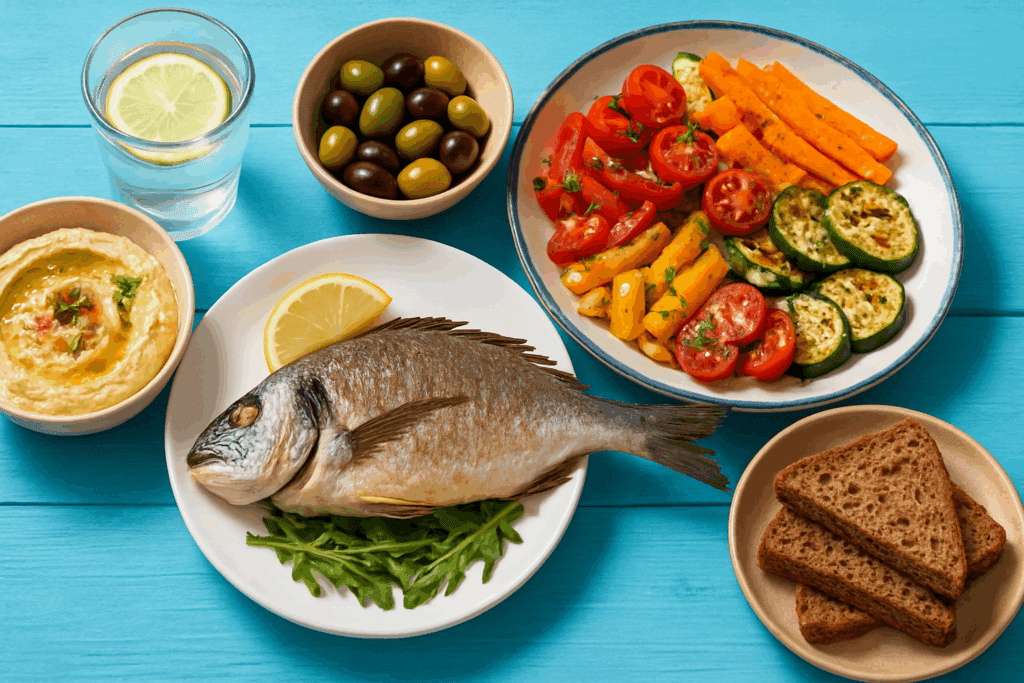
What Is the Healthiest Diet to Lose Weight?
When evaluating what is the healthiest diet to lose weight, experts often look at dietary patterns rather than individual foods. The Mediterranean diet consistently ranks among the most effective for weight loss and overall health. This plant-forward eating style emphasizes vegetables, fruits, legumes, whole grains, lean proteins, and healthy fats like olive oil. It has been shown in numerous studies to promote weight loss, reduce inflammation, and lower the risk of chronic disease.
Other effective approaches include the DASH diet, which is rich in potassium, magnesium, and calcium; and high-protein, moderate-carb plans that focus on maintaining lean mass while reducing body fat. Each of these dietary patterns can be tailored into a meal plan for weight loss for female or male individuals by adjusting portion sizes, calorie goals, and macronutrient ratios based on age, activity level, and metabolic needs.
Importantly, the healthiest meals for losing weight are those that people enjoy and can sustain. Diets that are overly restrictive or cut out entire food groups often fail in the long term. By focusing on variety, moderation, and whole-food quality, individuals can find what is the way to eat while losing weight that fits their lifestyle.
Weight Loss Meal Plans Tailored to Gender-Specific Needs
Nutritional needs and weight loss strategies can differ slightly between men and women due to hormonal, metabolic, and muscle mass differences. A diet plan for weight loss for female individuals should account for menstrual cycle changes, potential iron needs, and hormonal fluctuations that affect cravings and energy. In contrast, a weight loss diet for men may place greater emphasis on higher protein intake to support lean muscle mass and testosterone regulation.
That said, both men and women benefit from the foundational principles of nutrient-dense, portion-conscious meals built around whole foods. Whether following a meal plan for weight loss female programs or designing a diet for weight loss for male clients, the goal remains the same: to reduce excess calories while maximizing nutritional intake.
Meal planning tools, digital apps, or registered dietitian guidance can help tailor plans that accommodate personal goals, preferences, and medical history. This level of customization supports adherence and allows for realistic progress without the stress of rigid dieting.
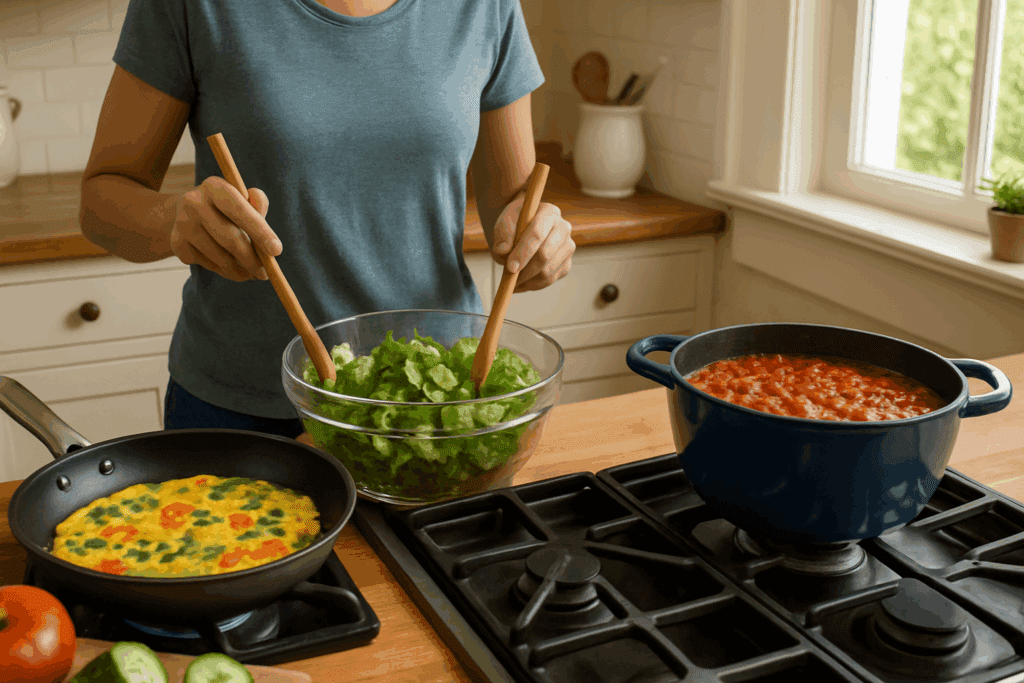
What I Ate to Lose Weight: Real-World Examples from Experts and Patients
One of the most relatable ways to explore effective eating strategies is through real-world experiences. Many health professionals and patients have shared “what I ate to lose weight” stories that demonstrate how simple, consistent habits can lead to significant change. These stories often revolve around similar themes: cutting out added sugars, increasing vegetable intake, preparing meals at home, and prioritizing protein at every meal.
For instance, someone might begin their day with a vegetable omelet and berries, enjoy a grilled chicken salad with chickpeas and vinaigrette for lunch, and end with a bowl of turkey chili and steamed broccoli for dinner. These meals are not only delicious but also fit into easy healthy meals for weight loss frameworks.
Hearing what foods are good for losing weight from those who have succeeded in their goals can also be motivating. It reinforces the idea that success doesn’t require perfection—just consistent, sustainable decisions guided by expert-backed principles.
Healthy Eating Ideas to Lose Weight That You Can Start Today
A key strategy in making progress is finding healthy eating ideas to lose weight that are both satisfying and enjoyable. Instead of focusing on what to eliminate, it’s often more effective to focus on what to add. Incorporating more non-starchy vegetables, choosing lean proteins, and cooking more meals at home are habits that build momentum.
Snacks are another area to refine. Instead of reaching for processed chips or cookies, consider plain Greek yogurt with cinnamon, apple slices with almond butter, or a boiled egg with sliced cucumbers. These swaps support what to eat while trying to lose weight because they stabilize blood sugar and prevent overeating at meals.
By keeping meals simple and flavorful, people are more likely to stay consistent. A dinner of shrimp stir-fried with snow peas and brown rice or a breakfast smoothie with spinach, banana, and protein powder are great examples of what foods are the healthiest for weight loss and how easy it can be to integrate them into a busy schedule.
What Are Foods I Can Eat to Lose Weight That Won’t Leave Me Hungry?
A frequent concern with weight loss diets is the fear of constant hunger. Fortunately, choosing the right foods can make a major difference. Foods high in both protein and fiber are the most satiating and help delay hunger between meals. Chickpeas, lentils, quinoa, eggs, and fatty fish like salmon are excellent options. These foods are often included in the best diet to lose weight because they nourish the body without creating energy crashes.
Adding bulk to meals through non-starchy vegetables is another powerful trick. These veggies good for weight loss provide volume and nutrients with minimal calories. When paired with a protein source, such as grilled chicken and roasted vegetables over farro, the result is a meal that satisfies both the body and mind.
What are good foods to eat to lose weight without feeling restricted? Start with options that are versatile, like eggs, oats, leafy greens, berries, nuts, and legumes. These can be prepared in countless ways, so boredom never becomes a problem.

What Foods to Eat to Lose Weight Fast While Staying Healthy
While sustainable weight loss is a gradual process, some individuals may seek initial momentum or need to lose weight quickly for health-related reasons. In such cases, the emphasis should still remain on balanced, nourishing meals. What foods to eat to lose weight fast without jeopardizing health? Prioritize lean proteins like turkey, fish, and eggs, pair them with high-volume, low-calorie vegetables, and minimize added sugars and refined grains.
Rapid results are more likely when meals are homemade, portion sizes are monitored, and consistency is maintained. Instead of skipping meals, focus on shrinking portions slightly, adding more fiber, and staying hydrated. Small, strategic changes—such as swapping soda for sparkling water or trading white bread for whole grain—accumulate over time.
Even in accelerated plans, the goal should be to build sustainable habits. Crash diets or extreme deprivation often backfire. But a steady diet of weight loss foods like leafy greens, legumes, berries, and lean proteins can safely enhance fat-burning and overall wellness.
Frequently Asked Questions: What to Eat for Weight Loss
1. Can I still enjoy carbs and follow the best diet to lose weight?
Absolutely—carbohydrates are often unfairly demonized, but they can play a valuable role in the best diet to lose weight when chosen wisely. Complex carbohydrates such as quinoa, oats, brown rice, and sweet potatoes are considered excellent weight loss foods because they are rich in fiber, which aids digestion and promotes fullness. Including these in healthy meals for weight loss not only stabilizes blood sugar but also helps prevent cravings that often lead to overeating. When building weight loss meal plans, pairing whole grains with protein and healthy fats ensures a balanced plate that fuels your body. The key is to avoid processed, refined carbs and instead focus on carbs that support easy healthy meals for weight loss in a sustainable and energizing way.
2. What’s the biggest mistake people make when choosing weight loss meals?
One of the most common mistakes is prioritizing calorie reduction over nutrient density. Many individuals opt for low-calorie snacks that lack fiber or protein, leaving them hungry and more likely to binge later. This approach often undermines even the healthiest meals for losing weight. A better strategy is to focus on satisfying meals that support hormonal balance and blood sugar control. For example, skipping meals may seem helpful initially, but it disrupts your metabolism and makes weight loss meal plans less effective. Instead of focusing solely on what foods to eat to lose weight fast, shift your mindset toward long-term satisfaction and nutrient-rich ingredients in your weight loss meals.
3. How can busy professionals incorporate easy weight loss meals into their workweek?
For professionals with tight schedules, meal prep is one of the most powerful tools. Spending just two hours on a Sunday preparing a few batch-cooked proteins, chopped vegetables, and a couple of sauces can yield an entire week’s worth of easy weight loss meals. These prepped components can be quickly assembled into different weight loss meal ideas, such as chicken and roasted veggie bowls, salmon salads with avocado, or bean chili with leafy greens. With strategic planning, even a demanding workweek can include some of the healthiest meals for losing weight. It’s all about keeping your fridge stocked with what are good foods to eat to lose weight that are easy to mix and match.
4. How do gender-specific needs affect weight loss meal plans?
Biological sex plays a meaningful role in how the body responds to different weight loss foods. A diet plan for weight loss for female individuals should account for hormonal fluctuations, especially during menstruation, menopause, or conditions like PCOS. Higher iron intake, plant-based omega-3s, and steady complex carbs may help balance energy levels and mood. In contrast, a diet for weight loss for male individuals often emphasizes protein to preserve muscle mass and testosterone levels. Regardless of gender, both groups benefit from weight loss meal ideas that include lean proteins, veggies good for weight loss, and healthy fats—but the nuances in quantity and timing may vary to optimize results for each.
5. What role does snacking play in healthy eating ideas to lose weight?
Snacking can either support or sabotage weight loss, depending on the choices you make. Including planned, nutritious snacks in your day—such as a handful of almonds, plain Greek yogurt, or carrot sticks with hummus—can actually prevent overeating during main meals. The best snacks are those that reflect the same principles as healthy meals for weight loss: protein, fiber, and healthy fat. When integrated into a structured eating routine, snacks can become an intentional part of what is the way to eat while losing weight. This approach prevents energy dips and promotes metabolic consistency, which supports a healthy and sustainable weight loss journey.
6. How can I personalize my meal plan for weight loss female or male goals?
Personalization is the cornerstone of effective weight loss meal plans. A meal plan for weight loss female goals might emphasize iron-rich foods, balanced carbs for hormone stability, and calorie cycling across the menstrual cycle. On the other hand, a weight loss diet for men may prioritize higher protein portions and resistance training to preserve muscle mass during fat loss. Both approaches benefit from tracking energy needs, activity levels, and preferences to ensure meals feel satisfying and manageable. Ultimately, what is a good diet to lose weight is one that aligns with your biology, your lifestyle, and your emotional relationship with food.
7. Are there psychological strategies that enhance what to eat when trying to lose weight?
Yes—cognitive and behavioral approaches can significantly influence eating patterns. Techniques like mindful eating, journaling your food choices, and setting intention-based goals all enhance awareness of what to eat when trying to lose weight. Emotional eating often interferes with even the most well-designed weight loss meal plans, so identifying stress triggers is essential. Many people also benefit from reframing their mindset around food—from punishment or control to nourishment and care. Aligning your emotional state with healthy eating ideas to lose weight ensures that you’re not just eating the right foods, but doing so in a way that supports long-term mental and physical well-being.
8. What’s the best way to stay consistent with healthy meals for weight loss during social events or travel?
Consistency doesn’t mean rigidity. When eating out or traveling, look for meals that resemble your go-to weight loss foods: lean protein, vegetables, and whole grains. At restaurants, swap fries for a side salad or ask for grilled instead of fried proteins. Even when off your routine, you can usually find easy weight loss meals that align with your goals. Having a list of adaptable weight loss meal ideas helps you make smart choices without stress. What foods are the healthiest for weight loss are often available in most places—you just need to prioritize whole, minimally processed ingredients whenever possible.
9. Can I use fasting or meal timing strategies to improve the results of weight loss foods?
Meal timing strategies such as intermittent fasting or time-restricted eating can be effective for some individuals, especially when paired with nutrient-rich weight loss meals. These methods work by optimizing insulin sensitivity and allowing for longer digestive rest periods. However, success with these strategies still depends on what foods are good for losing weight. Fasting is not a magic solution—it must be paired with smart, satisfying meals that support energy and recovery. For many, eating within a consistent 10–12 hour window while focusing on the best diet to lose weight can enhance both metabolic flexibility and meal satisfaction.
10. What’s the future of nutrition science in developing better weight loss meal plans?
The future lies in personalized nutrition—using biomarkers, genetic testing, and microbiome data to develop highly specific weight loss meal plans. Already, researchers are studying how gut bacteria affect fat metabolism and appetite signaling, which could revolutionize what foods to eat to lose weight fast and sustainably. New technologies are also emerging to track nutrient absorption, satiety hormones, and blood glucose responses to specific meals. These advancements will allow dietitians to craft weight loss meal ideas that are not just effective, but uniquely tailored to each individual’s physiology. What is the healthiest diet to lose weight may soon be a fully individualized answer based on scientific insight, rather than broad recommendations.
The Takeaway: Mastering What to Eat for Weight Loss Starts with Smart, Sustainable Choices
Ultimately, mastering what to eat for weight loss is less about trendy hacks and more about returning to the fundamentals of healthy nutrition. Choosing the right foods—those that are rich in fiber, protein, and nutrients—can create meals that are both satisfying and supportive of long-term success. From easy weight loss meals to personalized weight loss meal plans, the most effective strategies are those that align with individual preferences, biological needs, and lifestyle constraints.
Whether you’re following a diet plan for weight loss for female hormonal needs or designing a weight loss diet for men focused on muscle retention, the principles remain consistent: build your meals around real, whole foods, listen to your body’s signals, and aim for progress over perfection.
In the end, the healthiest meals for losing weight are those you can enjoy and sustain—not just for a week, but for a lifetime. With expert-recommended insights, practical meal planning, and a commitment to consistency, anyone can discover what foods are the healthiest for weight loss and build a path to better health—one delicious, nourishing bite at a time.
Further Reading:
Great Food Combos for Losing Weight
Weight loss: Feel full on fewer calories
16 of the Best Foods for Your Healthy Weight Journey


